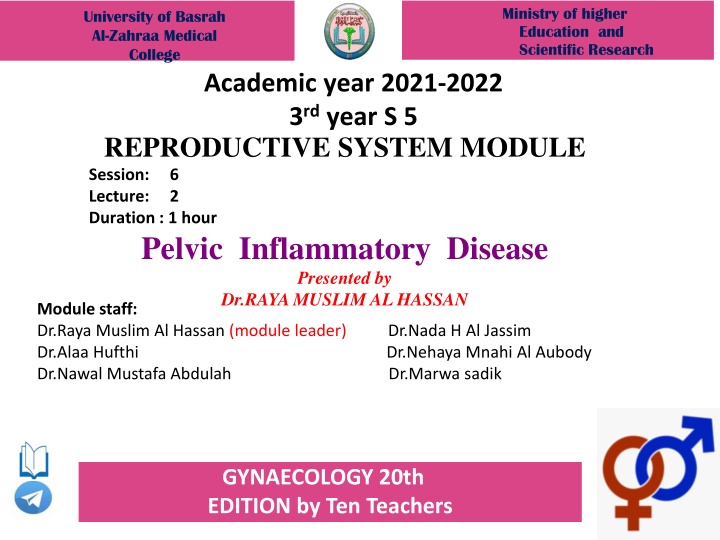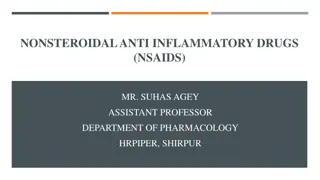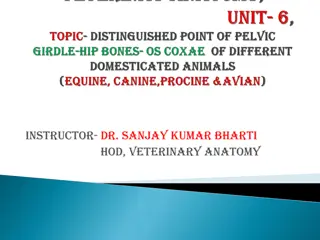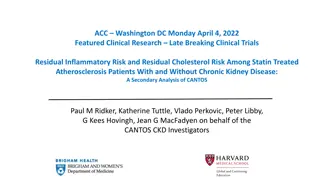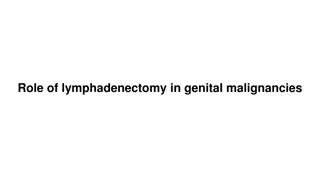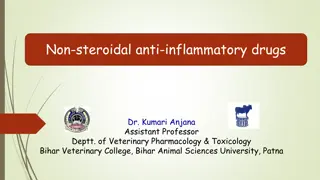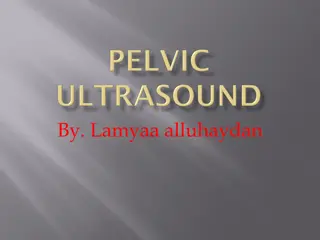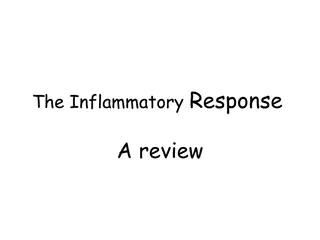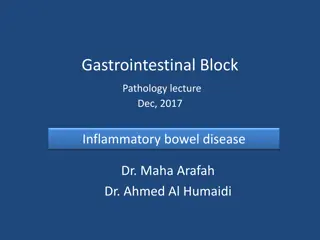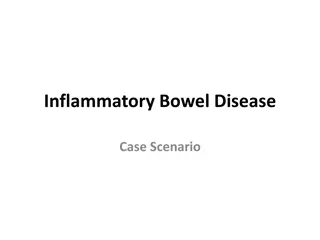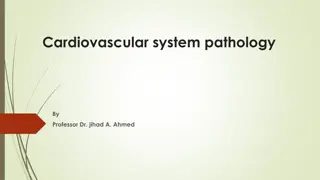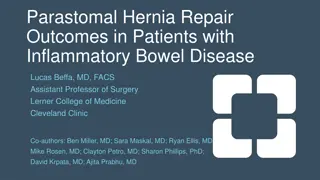Pelvic Inflammatory Disease
Pelvic Inflammatory Disease (PID) is explored in the academic context at the University of Basrah's Al-Zahraa Medical College for the academic year 2021-2022. The session delves into the causes, symptoms, risk factors, and diagnosis of PID, providing crucial insights for medical students. The lecture, presented by Dr. Raya Muslim Al Hassan, sheds light on the pathogenesis and clinical manifestations of PID, offering a comprehensive overview for aspiring medical professionals.
Uploaded on Mar 06, 2025 | 1 Views
Download Presentation

Please find below an Image/Link to download the presentation.
The content on the website is provided AS IS for your information and personal use only. It may not be sold, licensed, or shared on other websites without obtaining consent from the author.If you encounter any issues during the download, it is possible that the publisher has removed the file from their server.
You are allowed to download the files provided on this website for personal or commercial use, subject to the condition that they are used lawfully. All files are the property of their respective owners.
The content on the website is provided AS IS for your information and personal use only. It may not be sold, licensed, or shared on other websites without obtaining consent from the author.
E N D
Presentation Transcript
Ministry of higher Education and Scientific Research University of Basrah Al-Zahraa Medical College Academic year 2021-2022 3rd year S 5 REPRODUCTIVE SYSTEM MODULE Session: 6 Lecture: 2 Duration : 1 hour Pelvic Inflammatory Disease Presented by Dr.RAYA MUSLIM AL HASSAN Module staff: Dr.Raya Muslim Al Hassan (module leader) Dr.Nada H Al Jassim Dr.Alaa Hufthi Dr.Nehaya Mnahi Al Aubody Dr.Nawal Mustafa Abdulah Dr.Marwa sadik GYNAECOLOGY 20th EDITION by Ten Teachers
Ministry of higher Education and Scientific Research University of Basrah Al-Zahraa Medical College Pelvic Inflammatory Disease (PID) Pelvic Inflammatory Disease (PID) is an ascending infection from the endocervix causing: 1. Endometritis 2. Salpingitis 3. Oophoritis 4. Pelvic peritonitis 5. +/- tubo ovarian abscess
Ministry of higher Education and Scientific Research University of Basrah Al-Zahraa Medical College Risk Factors ????
Ministry of higher Education and Scientific Research University of Basrah Al-Zahraa Medical College Causative Organisms Most cases are polymicrobial, the causative M.O. Of PID: 1. Nesseria Gonorrhoea Gram ve intracellular diplococci 2. Chlamydia Trachomatis Gram ve obligate intracellular M.O 3. Bacterial Vaginosis Anareobes, Enteric Gram ve Bacteroides 4. Streptococci 5. Haemophillis Influenzae 6. Cytomegalovirus 7. Mycobacterium Tuberculosis
Pathogenesis Ministry of higher Education and Scientific Research University of Basrah Al-Zahraa Medical College Pathogenesis Infection of the cervix (endocervicitis) spreads, either directly or via lymphatics to the endometrium, uterine tubes and the pelvic peritoneum. Peritonitis Salpingitis/ oophoritis/ tubo- ovarian abscess Endometritis Cervicitis 5
Diagnosis Ministry of higher Education and Scientific Research University of Basrah Al-Zahraa Medical College Clinical criteria Abdominal, pelvic pain & dyspareunia Temperature >38 C Abnormal cervical mucopurulent discharge. Heavy/inter-menstrual bleeding Adenexal, pelvic tenderness &/or cervical motion tenderness (cervical excitation). Pelvic mass 6
Clinical Manifestations Ministry of higher Education and Scientific Research University of Basrah Al-Zahraa Medical College Classification Mild to moderate symptoms 36% Subclinical/ silent 60% Overt 40% Severe symptoms 4% 7
Diagnosis Ministry of higher Education and Scientific Research University of Basrah Al-Zahraa Medical College Mucopurulent Cervical Discharge (Positive swab test) Source:Seattle STD/HIV Prevention Training Center at the University of Washington/ Claire E. Stevens and Ronald E. Roddy 8
Ministry of higher Education and Scientific Research University of Basrah Al-Zahraa Medical College Sequelae of PID Immediate Tubo-ovarian abscess Pyo-salpinx Long Term Ectopic Pregnancy Tubal infertility Dyspareunia (Painful sexual intercourse) Chronic PID / Chronic pelvic pain Pelvic adhesions
Ministry of higher Education and Scientific Research University of Basrah Al-Zahraa Medical College Chronic Pelvic Inflammatory Disease Symptoms > 6 Months Duration Pelvic pain Secondary dysmenorrhoea Deep dyspareunia Menstrual disturbance Recurrent acute painful exacerbations
Ministry of higher Education and Scientific Research University of Basrah Al-Zahraa Medical College Diagnosis A- Laboratory Investigations of PID Pregnancy test Triple and urethral swabs High vaginal swab Bacteria vaginosis organisms Endocervical swab Neisseria gonorrhoea Endocervical swab - Chlamydia trachomatis Urethral swab Chlamydia trachomatis (males only) Midstream Urine Leucocytes and nitrates C-Reactive Protein and ESR Markers for acute infection / inflammation The presence of leucocytes on vaginal wet preparation.
Diagnosis Ministry of higher Education and Scientific Research University of Basrah Al-Zahraa Medical College B - Other investigations 1. Transvaginal sonography or MRI. for pelvic mass 12
Ministry of higher Education and Scientific Research University of Basrah Al-Zahraa Medical College 2. Laparoscopy a. Left tubal hydrosalpinx c. Peritubal adhesions b. Bilateral hydrosalpinx
Ministry of higher Education and Scientific Research University of Basrah Al-Zahraa Medical College Perihepatic adehesions (Fitz-Hugh-Curtis syndrome)
Ministry of higher Education and Scientific Research University of Basrah Al-Zahraa Medical College Differential Diagnosis 1) Ectopic pregnancy 2) Acute appendicitis 3) Irritable Bowel Syndrome (IBS) 4) Ovarian cyst accidents (torsion, rupture, haemorrhage) 5) Urinary Tract Infection (UTI) 6) Functional pelvic pain of unknown origin
Management Ministry of higher Education and Scientific Research University of Basrah Al-Zahraa Medical College Treatment Regimens must provide coverage of N. gonorrhoeae, C. trachomatis, anaerobes, Gram-negative bacteria, and streptococci. ( A combination of ceftriaxone, doxicycline & metronidazole) Treatment should be instituted as early as possible to prevent long term sequelae. In the patient with a pelvic abscess, surgery is warranted. For drainage of abscess+/-salpingo- oopherectomy. 16
